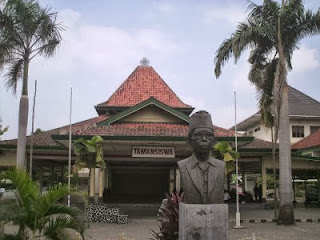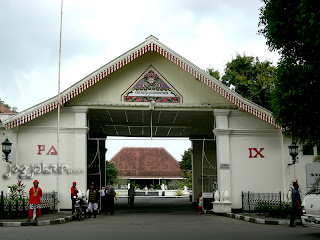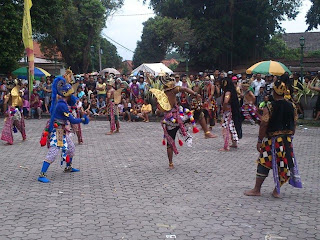
Sewu Temple located in Bener Hamlet, Village Bugisan, District Prambanan, Klaten Regency, Central Java Province. From Yogyakarta city located about 17 km to the Solo. Sewu temple is a cluster of temples that is located adjacent to the Prambanan Temple, which is approximately 800 meters to the south of the statue Rara Jongrang.
The temple was probably built in the 8th century, on the orders of the ruler of the Mataram kingdom at that time, namely Rakai Panangkaran (746-784 AD) and Rakai Pikatan his Hindu. Although the Hindu king, the kingdom of Mataram in the past received a strong influence of Buddhist Sailendra Dynasty. Experts suspect that the Sewu temple is the center of religious activities of Buddhist society. The assumption is based on the content of andesite stone inscription found in one of the ancillary temples. The inscription written in Old Malay and in 792 of the Saka known as Inscription Manjusrigrta. In the inscriptions tell about the improvement activities prasada named Wajrasana Manjusrigrha in 714 Saka (792 AD). The name is also mentioned in the inscription Manjushri Kelurak year 782 AD found near the Temple Barn.
Sewu Temple is located alongside the Prambanan Temple, Sewu temple currently included in the tourist area of Prambanan temple. In the neighborhood there is also a tourist area of Candi Lumbung and Candi Bubrah. Not far from the area there are also several other temples, namely: Gana temple, about 300 m to the east, Temple Kulon approximately 300 m to the west, and the Temple Lor approximately 200 m to the north. Location of Sewu temple, the largest Buddhist temple after temple of Borobudur, Prambanan temple with, which is a Hindu temple, shows that at that time the people are Hindus and Buddhist communities living side by side in harmony.
Name Sewu, which in Javanese means thousand, indicating that the temple belonging to the cluster Sewu is large enough, although not actually reach 1000 pieces. Precisely, the cluster consists of 249 Sewu temples, the main temple consists of 1, 8 flanking temple or temple between, and 240 ancillary temples. The main temple is located in the center, surrounded on all four sides by a clamp and ancillary temples temples in a symmetrical arrangement.
Sewu Temple has 4 gateway to the outer court, which is on the east, north, west, and south, each guarded by a pair of statues Dwarapala facing each other. From the outer court to the inner court there are also 4 entrance guarded by a pair of statues Dwarapala, similar to those contained in the outer gate.
Dwarapala statues made of stone placed on top of the whole square pedestal as high as about 1.2 m in a kneeling position one leg, the other leg bent, and one hand holding a mace. Dwarapala high statue is reached about 2.3 m.
The main temple located in the courtyard area of 40 m2 square, which is surrounded by a fence of 0.85 m tall stone structure. The temple building polygon-shaped angular diameter of 20 to 29 m. Reach 30 m high building with a roof 9 each having a stupa on top.
The temple sits on a 2.5 m high base. Foot floral sculptures of the temple are decorated in a vase. To reach the surface of the shelf that forms the hallway, there are about 2 m wide staircase that comes with cheek ladder. The base of the stairs decorated cheek makara, dragon head with gaping mouth, with statues of Buddha in it. The outside walls are decorated with sculptured cheek intangible giant ladder Kalpawreksa.
Above the threshold there is Kalamakara, but the wall on the left and right of the doorway is decorated with a dragon head carved gaping mouth. Different from that contained in the base of the stairs cheek, not Buddha contained in the dragon's mouth, but the lion.
The main temple is built of stone is andesite has a main entrance on the east, so that it can be said that the main temple is facing east. In addition to the main door, there are 3 other doors, which are facing north, west and south. All entrances are equipped with a walk-viewer. The temple's interior cube shaped with walls made of red brick. In this room there is a 'asanas'. On the outer wall of the body and legs roof of the temple there are niches containing statues of Buddha in various positions.
Ancillary temples and entirely enclose the temple is located in the outer court. On each side of the temple there is a pair of wedge that sits between the main temple in a complex of ancillary temples. Each pair flanking the temple facing the wedge that divides the road leading to the main temple courtyard.
The temple stands on a wedge of about 1 m tall platform, equipped with a 1 meter wide staircase leading to the hall on the surface of the foot of the temple. Above the doorway is not decorated sculptures Kalamakara, but some relief panels. Stupa temple roof with rows of small stupas adorn the base. The walls enclose the body of the temple is decorated with figures dressed man of greatness, seems like a god, in a standing position holding a sprig of lotus in her hand.
Ancillary temples built respectively in four rows around the outer side of the main temple and the temple wedge. In the building there are 28 rows deep, the second row there are 44 buildings, 80 buildings are the third row, and a row of four to 88 buildings. All ancillary temples, except those in the third row, facing outward or back to the main temple. Just who are in the third row facing inwards. Most of the objec perwara damaged, no more than a pile of stones.






